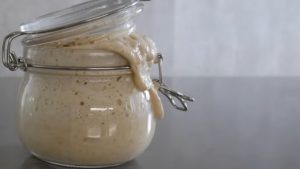This recipe is all about creating a natural leaven for sourdough bread at home. It's a simple process that only requires four ingredients and some patience. Over the course of a week or two, you'll cultivate wild yeast and lactic acid bacteria that will give your homemade sourdough bread its characteristic tang and depth of flavor.
The ingredients for this recipe are generally common, but there might be two unfamiliar ones to some: whole wheat flour and bread flour. Whole wheat flour is made from the entire wheat kernel and it gives the starter a richer flavor and more nutrients. Bread flour, on the other hand, has higher protein content than all-purpose flour, which helps to develop the gluten structure in bread dough. If these are not available in your pantry, you can easily find them in the baking aisle of your local supermarket.
Sourdough Starter Recipe Ingredients
Whole wheat flour: This is a type of flour made from the entire kernel of wheat. It is denser and has a stronger flavor than white flour. It also contains more fiber, protein, and vitamins.
Bread flour: This is flour specifically formulated for baking bread. It has a higher protein content than all-purpose flour, which helps to develop the gluten structure necessary for bread to rise.
Warm water: This is used to hydrate the flour and activate the yeast. The water should be warm but not hot to touch.
Cool water: This will be used for the float test, to check if your starter is ready for baking.
One reader, Evin Osullivan says:





I recently tried out the sourdough starter recipe and it worked like a charm! The instructions were clear and easy to follow, and the end result was a lively and bubbly starter that made my bread taste amazing. I'm so excited to continue using it for all my sourdough baking adventures!
Key Techniques for Crafting a Robust Sourdough Starter
How to create a sourdough starter: A step-by-step guide on how to create a sourdough starter from scratch using whole wheat flour, bread flour, and warm water.
How to feed the sourdough starter: Instructions on how to maintain and feed the sourdough starter daily to keep it active and healthy.
How to perform the float test: A method to determine if the sourdough starter is ready for baking by observing its buoyancy in water, indicating its readiness to leaven bread.
How To Make Sourdough Starter
Make your own homemade sourdough starter to work on baking a rich sourdough bread! It’s made with just 4 ingredients for a great starter.
Serves:
Ingredients
- ⅓cupwhole wheat flour,plus more for feeding
- ⅓cupbread flour,plus more feeding
- ⅓cupwarm water,plus more for feeding
- cool water,for testing
Instructions
Day 1:
-
Add the whole wheat flour, bread flour, and warm water to a clear lidded container with a capacity of 1 pint or more.
-
Mix until there are no dry spots. Scrape down the sides of the container with a spatula. Cover with a lid.
-
Use a rubber band or piece of tape to mark the mixture level.
-
Set the starter in a warm spot. Let sit for 24 hours.
Day 2:
-
After 24 hours, open the container and look for signs of fermentation in the form of bubbles on top, volume growth, or a musty, slightly sweet acidic smell.
-
If not, cover the starter again and let sit for another 12 to 24 hours, until these signs appear.
-
Once the starter has gotten a bit bubbly, discard all but about 2 tablespoons of starter.
-
Add another ⅓ cup of warm water, then stir to dissolve the remaining starter.
-
Add ⅓ cup of bread flour and ⅓ cup of whole wheat flour, then stir until there are no dry spots.
-
Cover and let sit in a warm spot for another 24 hours.
Days 3 to 15:
-
Repeat the feeding process every day for 7 to 14 days. Once the starter is rising and falling regularly, it is in a good place.
Float Test:
-
Fill a cup with cool water.
-
Use a clean spoon to take a scoop of the starter, being careful not to stir the starter and deflate the air bubbles that make it float, then carefully plop it in the water.
-
If it floats, it is gassy and alive and ready to make some bread.
-
If not, either wait longer if it has only been a few hours since feeding, or if it has been closer to 24 hours since feeding, discard and feed again.
-
After passing the float test, the starter is ready to use for baking. Enjoy!
Recipe Notes
- If using the starter when it is young, only a few hours after feeding when it just passes the float test, it will smell sweet. For a more sour taste, use the starter 6 to 12 hours after feeding, when it will be more mature and smell a bit more vinegary and musty.
- Mold: If there are any fuzzy moldy spots on the starter that are black, red, or blue unless it is very easy to scrape them off the top, but unfortunately, one would need to start over. Sometimes, a while after feeding or being in the refrigerator, the starter will develop a dark, clear liquid on top. This is called hooch and is harmless. Just pour the liquid off!
- Flour: Use what flour is available. Just know that the starter may need to feed more often because it gets musty more quickly.
- Discard: It may be tempting not to discard most of the starter every time it’s fed, but discarding has a variety of reasons. This gives the starter a lot of fresh food and water to eat. If not discarded, the starter will retain a lot of that musty smell and also eventually grow to be huge if one just keeps adding water and flour to it. It can be discarded into another container and keep that container in the refrigerator until needed for other baking projects. The discard mix can be folded into banana bread, pancakes, cookies, etc.
- Storage: Once the starter is up and running, either keep it at room temperature and feed it daily, or store it in the refrigerator. To store in the refrigerator, do a regular discard and feed, then place in the refrigerator. A day before making bread, pull the starter out and let it come to room temperature. Then, discard and feed as usual.
- Scaling: This starter recipe calls for equal amounts of water and total flour by weight. Scale this recipe up or down as needed, depending on how much starter the recipe was chosen calls for.
Nutrition
- Calories: 300.86kcal
- Fat: 1.76g
- Saturated Fat: 0.28g
- Monounsaturated Fat: 0.18g
- Polyunsaturated Fat: 0.80g
- Carbohydrates: 61.91g
- Fiber: 5.38g
- Sugar: 0.31g
- Protein: 10.75g
- Sodium: 4.87mg
- Calcium: 22.82mg
- Potassium: 190.87mg
- Iron: 3.45mg
Mastering the Art of Feeding Your Sourdough Starter
Maintaining a consistent temperature is crucial for the successful fermentation of your sourdough starter. A warmer environment accelerates the fermentation process, while a cooler one slows it down. If your kitchen is particularly cold, you might consider placing your starter in a slightly warmer spot, like the top of the refrigerator or inside the oven with the light on. Conversely, if your kitchen is hot, you might need to find a cooler spot or feed your starter more frequently to prevent it from over-fermenting.
Time-Saving Tips for Creating a Sourdough Starter
Plan ahead: Make a schedule for feeding your starter at the same time every day to establish a routine.
Use a kitchen scale: Weighing your ingredients will ensure accuracy and consistency in your sourdough starter.
Substitute Ingredients For Sourdough Starter Recipe
whole wheat flour - Substitute with rye flour: Rye flour can be used as a substitute for whole wheat flour in sourdough starter recipes, as it adds a similar nutty flavor and contributes to the fermentation process.
bread flour - Substitute with all-purpose flour: All-purpose flour can be used as a substitute for bread flour in sourdough starter recipes, as it provides a similar gluten content and helps in developing the starter's structure.
warm water - Substitute with room temperature water: Room temperature water can be used as a substitute for warm water in sourdough starter recipes, as it allows the natural fermentation process to occur without affecting the temperature of the mixture.
cool water - Substitute with filtered water: Filtered water can be used as a substitute for cool water in sourdough starter recipes, as it helps maintain the purity of the water and supports the growth of beneficial microorganisms.
Creative Ways to Present Your Homemade Sourdough Starter
Artful plating: When presenting the sourdough starter, consider using a beautiful, handcrafted ceramic or glass container to showcase the starter. The vessel should complement the rustic and artisanal nature of the sourdough starter.
Garnish with herbs: Add a touch of freshness and color by garnishing the sourdough starter with a few delicate sprigs of fresh herbs, such as thyme or rosemary. This not only enhances the visual appeal but also adds a subtle herbal aroma.
Incorporate texture: Consider serving the sourdough starter with a side of crispy breadsticks or toasted sourdough bread. This adds a delightful crunch and contrasts the creamy texture of the starter.
Elevate with edible flowers: For a touch of elegance, consider adorning the sourdough starter with a few carefully placed edible flowers, such as nasturtiums or pansies. The vibrant colors and delicate petals will elevate the presentation.
Accentuate with drizzles: A fine drizzle of extra virgin olive oil or balsamic reduction on top of the sourdough starter can add a layer of complexity and visual appeal, enhancing the overall presentation.
Serve on a wooden board: Present the sourdough starter on a rustic wooden board to create a warm and inviting aesthetic. This adds a touch of earthiness and complements the natural, homemade quality of the starter.
Essential Tools for Making a Perfect Sourdough Starter
- Mixing bowl: A large, deep bowl used for combining ingredients and mixing batters or doughs.
- Measuring cups and spoons: Essential for accurately measuring ingredients for recipes.
- Digital scale: Useful for precise measurements, especially for baking recipes.
- Dutch oven: A heavy, thick-walled pot with a tight-fitting lid, ideal for baking sourdough bread.
- Bench scraper: A versatile tool for cutting and portioning dough, as well as cleaning work surfaces.
- Kitchen thermometer: Essential for monitoring the temperature of the sourdough starter and bread dough.
- Proofing basket: Also known as a banneton, it is used to support the dough while it rises and helps shape the bread.
- Lame or razor blade: Used for scoring the bread before baking to control the expansion of the dough.
- Oven: An essential appliance for baking the sourdough bread to perfection.
- Clean kitchen towel: Used for covering the dough during the resting and proofing stages.
How To Properly Store and Preserve Your Sourdough Starter
Once your sourdough starter is active and bubbly, it's time to store it for future use. If you plan to bake regularly, you can keep your starter at room temperature and feed it daily.
To store your starter in the fridge, first feed it as usual and let it sit at room temperature for an hour or two until it becomes active and bubbly. Then, place it in an airtight container and store it in the fridge. Your starter will go dormant in the cold environment, so you'll only need to feed it once a week.
When you're ready to bake with your refrigerated starter, take it out of the fridge and let it come to room temperature. Feed it as usual and wait until it becomes active and bubbly before using it in your recipe.
If you don't plan to bake for an extended period, you can also freeze your sourdough starter. To do this, feed your starter as usual and let it sit at room temperature until it becomes active. Then, spoon the starter into an ice cube tray and freeze until solid. Once frozen, transfer the starter cubes to a freezer-safe bag or container and store in the freezer for up to 3 months.
To revive a frozen starter, let a cube or two thaw at room temperature. Once thawed, transfer the starter to a clean jar and feed it with equal parts flour and water. Let the starter sit at room temperature and continue feeding it daily until it becomes active and bubbly again, which may take a few days.
Remember, the key to maintaining a healthy sourdough starter is regular feeding and proper storage. With a little care and attention, your starter will continue to thrive and provide you with delicious sourdough bread for years to come!
How To Revive a Dormant Sourdough Starter
The best way to reheat leftover sourdough starter is to let it come to room temperature for about an hour before using it in your recipe. This allows the starter to become active again and will result in better flavor and texture in your baked goods.
If you need to speed up the process, you can place the starter in a warm (not hot) water bath for 10-15 minutes. Be sure to use a glass or ceramic container, as metal can react with the starter and affect its flavor.
Another option is to feed your leftover starter with equal parts flour and water, then let it sit at room temperature for a few hours until it becomes bubbly and active. This will give your starter a boost of fresh nutrients and help it to perform better in your recipe.
If you have a large amount of leftover starter, you can also divide it into smaller portions and freeze them for later use. To thaw, simply place the frozen starter in the refrigerator overnight, then let it come to room temperature before using.
When reheating leftover starter, be sure to avoid using the microwave or any direct heat source, as this can kill the beneficial bacteria and yeast that give sourdough its unique flavor and texture. Gentle reheating methods like those mentioned above are best for preserving the integrity of your starter.
Fascinating Facts About the History of Sourdough Starters
Sourdough starters have been used for thousands of years, with the oldest recorded use dating back to ancient Egypt around 1500 BC. The process of fermenting flour and water to create a sourdough starter allows for the natural yeast and bacteria to develop, resulting in a unique flavor and texture in bread. This traditional method of leavening bread has been passed down through generations and continues to be a popular technique in baking today.
Is Making Your Own Sourdough Starter Cost-Effective?
The cost-effectiveness of this sourdough starter recipe is quite high, as it requires minimal ingredients and can be maintained with regular feeding. The initial investment in flour and water is low, and the starter can be used to make a variety of breads and pastries. The approximate cost for a household of 4 people over time is minimal, making it a budget-friendly option for those looking to incorporate homemade sourdough into their culinary repertoire. Overall Verdict: 9/10
Is Sourdough Starter Healthy or Unhealthy?
The sourdough starter recipe is relatively healthy, as it primarily consists of whole wheat flour, bread flour, and water. These ingredients are natural and minimally processed, providing a good source of complex carbohydrates and fiber. The fermentation process involved in creating a sourdough starter also offers potential health benefits, such as improved digestibility and increased bioavailability of nutrients.
However, there are a few aspects of the recipe that could be adjusted to make it even healthier:
- Consider using a higher proportion of whole wheat flour to bread flour, as whole wheat flour contains more fiber, vitamins, and minerals
- Experiment with incorporating other nutrient-dense flours, such as rye, spelt, or buckwheat, to increase the variety of nutrients in the starter
- Once the starter is established, try feeding it with organic, stone-ground flours to ensure the highest quality ingredients are being used
- When baking with the sourdough starter, opt for recipes that include additional healthy ingredients, such as seeds, nuts, or dried fruits, to boost the nutritional value of the final product
By making these minor adjustments, you can enhance the already healthy nature of the sourdough starter and ensure that the breads and baked goods made with it are as nutritious as possible. Remember, while sourdough bread can be a healthier choice compared to commercially produced breads, it should still be consumed in moderation as part of a balanced diet.
Editor's Opinion: Why Sourdough Starter is a Must-Try
The sourdough starter recipe provided is a comprehensive and well-structured guide for creating a robust and flavorful starter. The step-by-step instructions are clear and easy to follow, making it accessible for both novice and experienced bakers. The inclusion of the float test is a great way to ensure the starter is active and ready for use. Overall, this recipe is a great foundation for anyone looking to embark on their sourdough baking journey.
Enhance Your Sourdough Starter Recipe with These Unique Side Dishes:
Exploring Alternative Recipes Using Sourdough Starter
Was this page helpful?
Have your own special recipe to share? Submit Your Recipe Today!















